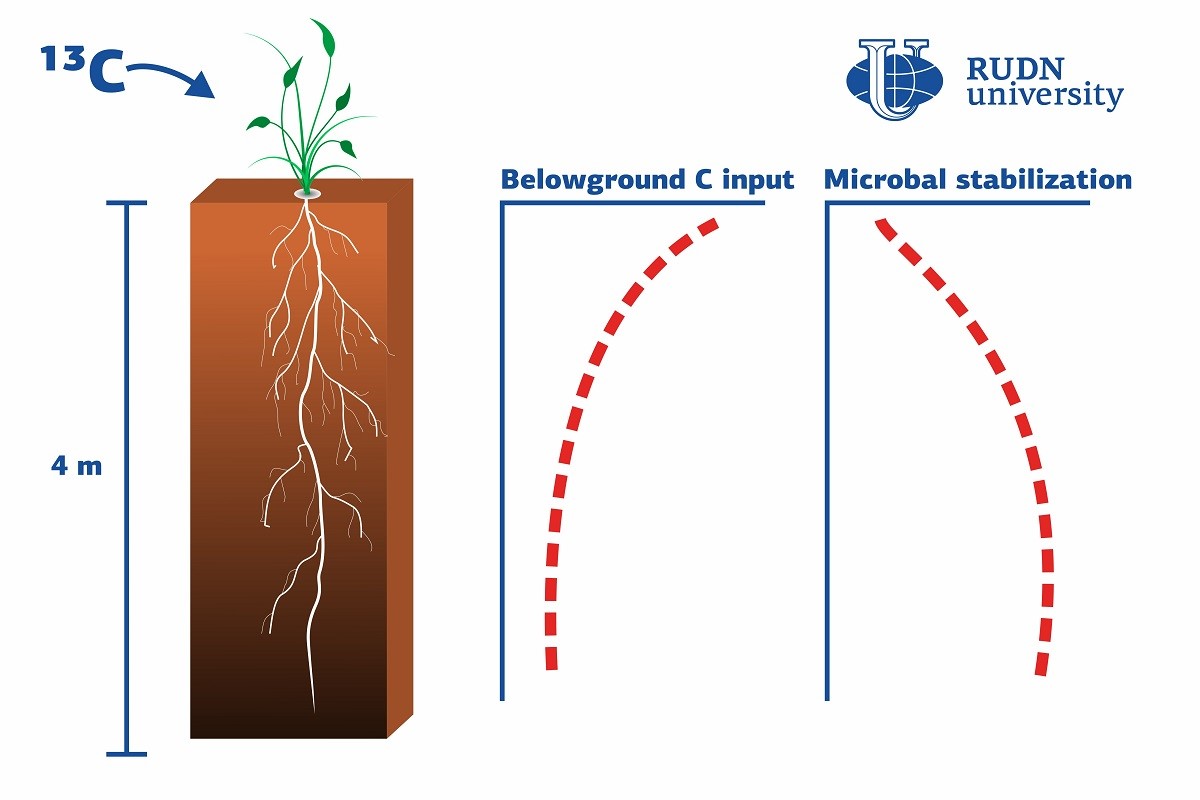RUDN soil scientist proves that deep plant roots will help curb climate change

Greenhouse gases in the atmosphere - primarily those containing carbon, cause global climate change. Much of the carbon is absorbed as carbon dioxide by plants, and after they die and decompose, it ends up in the soil. Part of the carbon is released back into the atmosphere as gases, while some may be retained in the soil in the form of organic residues. A soil scientist at the Russian University of Peoples Friendship has figured out how to increase the ability of soils to retain carbon at depth.
"The ability of soils to store organic carbon can mitigate the effects of global climate change, so it is important to look for ways to increase organic matter accumulation in soils. In recent years, researchers have focused on increasing organic carbon in the upper soil layer, while the possibility of increasing it in the layers below, especially those more than one meter deep, has been much less studied. However, the biochemical conditions of these layers suggest that organic matter will decompose more slowly, this will allow carbon to be retained for a longer period of time," Yakov Kuzyakov, Doctor of Biological Sciences, Head of the Center for Mathematical Modeling and Design of Sustainable Ecosystems RUDN.
One way to introduce carbon into deep layers of soil are perennial plants with a strong root system. As they penetrate deep into the soil, their roots loosen the soil, release carbon dioxide into it, "feed" the symbiotic bacteria that live on them, and die off. Soil scientists have studied three species of perennial plants - Medicago sativa, kernza (Thinopyrum intermedium), and whole-leaf silphium (Silphium integrifolium), that affect the deposition of organic matter in the deeper layers of the soil. The plants belong to different families, they are legumes, grasses and asters but all of them have roots that grow more than five meters deep.
Soil scientists planted the plants in transparent containers four meters high. The design of the containers allowed scientists to observe the growth of the root system, take soil, and root samples at any depth. To track how organic matter moves within the plants and is absorbed by microorganisms, the soil scientists used isotopic labeling. Leaves were immersed in a liquid containing the naturally rare carbon isotope 13C. The plants absorbed it and used it instead of the usual 12C. A few days after labeling, soil scientists took root and soil samples at seven different levels - from 0 to 3.6 m deep. By the amount of 13C at different depths, the scientists "traced" the carbon pathway in the plant and soil.
All plants "deposited" less and less carbon with increasing depth. Alfalfa showed the best result in carbon accumulation at a depth of 3.6 m - 8% of the absorbed carbon against 2.5% and 2.7% for kernza and silphium. It turned out that, for all three species, carbon at depth was predominantly contained in dead cells. This means that, unlike surface levels where dead organisms decay and emit carbon-containing gases, at depth the carbon is stabilized appears to be "fixed".
"We have demonstrated that even relatively small carbon inputs are stabilized in deep soil layers. This illustrates the potential in using deep-rooted crops (especially alfalfa) for deep soil carbon storage," explained Yakov Kuzyakov, Doctor of Biological Sciences
The results of the study were published in Soil Biology and Biochemistry.
The project to develop a cellular model of the placenta became the winner in the Scientific Materials category of the Young Scientists 3.0 competition, organized with the support of the Presidential Grants Foundation and T-Bank.
Ten scientific journals published by RUDN University have been included in the highest level of the state list of scientific publications, the White List.
Forests are not only the lungs of the planet, but also home to millions of species. However, it has remained unclear how underground interactions between trees and fungi affect forest species richness in different climatic conditions. Previous studies have yielded conflicting results: in some regions, the dominance of certain fungi reduced tree diversity, while in others it increased it.
The project to develop a cellular model of the placenta became the winner in the Scientific Materials category of the Young Scientists 3.0 competition, organized with the support of the Presidential Grants Foundation and T-Bank.
Ten scientific journals published by RUDN University have been included in the highest level of the state list of scientific publications, the White List.
Forests are not only the lungs of the planet, but also home to millions of species. However, it has remained unclear how underground interactions between trees and fungi affect forest species richness in different climatic conditions. Previous studies have yielded conflicting results: in some regions, the dominance of certain fungi reduced tree diversity, while in others it increased it.